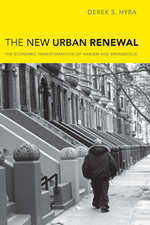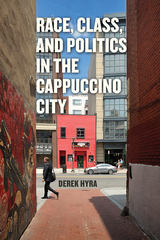2 books by Hyra, Derek S.

The New Urban Renewal
The Economic Transformation of Harlem and Bronzeville
Derek S. Hyra
University of Chicago Press, 2008
Two of the most celebrated black neighborhoods in the United States—Harlem in New York City and Bronzeville in Chicago—were once plagued by crime, drugs, and abject poverty. But now both have transformed into increasingly trendy and desirable neighborhoods with old buildings being rehabbed, new luxury condos being built, and banks opening branches in areas that were once redlined. In The New Urban Renewal, Derek S. Hyra offers an illuminating exploration of the complicated web of factors—local, national, and global—driving the remarkable revitalization of these two iconic black communities.
How did these formerly notorious ghettos become dotted with expensive restaurants, health spas, and chic boutiques? And, given that urban renewal in the past often meant displacing African Americans, how have both neighborhoods remained black enclaves? Hyra combines his personal experiences as a resident of both communities with deft historical analysis to investigate who has won and who has lost in the new urban renewal. He discovers that today’s redevelopment affects African Americans differentially: the middle class benefits while lower-income residents are priced out. Federal policies affecting this process also come under scrutiny, and Hyra breaks new ground with his penetrating investigation into the ways that economic globalization interacts with local political forces to massively reshape metropolitan areas.
As public housing is torn down and money floods back into cities across the United States, countless neighborhoods are being monumentally altered. The New Urban Renewal is a compelling study of the shifting dynamics of class and race at work in the contemporary urban landscape.
[more]

Race, Class, and Politics in the Cappuccino City
Derek S. Hyra
University of Chicago Press, 2017
For long-time residents of Washington, DC’s Shaw/U Street, the neighborhood has become almost unrecognizable in recent years. Where the city’s most infamous open-air drug market once stood, a farmers’ market now sells grass-fed beef and homemade duck egg ravioli. On the corner where AM.PM carryout used to dish out soul food, a new establishment markets its $28 foie gras burger. Shaw is experiencing a dramatic transformation, from “ghetto” to “gilded ghetto,” where white newcomers are rehabbing homes, developing dog parks, and paving the way for a third wave coffee shop on nearly every block.
Race, Class, and Politics in the Cappuccino City is an in-depth ethnography of this gilded ghetto. Derek S. Hyra captures here a quickly gentrifying space in which long-time black residents are joined, and variously displaced, by an influx of young, white, relatively wealthy, and/or gay professionals who, in part as a result of global economic forces and the recent development of central business districts, have returned to the cities earlier generations fled decades ago. As a result, America is witnessing the emergence of what Hyra calls “cappuccino cities.” A cappuccino has essentially the same ingredients as a cup of coffee with milk, but is considered upscale, and is double the price. In Hyra’s cappuccino city, the black inner-city neighborhood undergoes enormous transformations and becomes racially “lighter” and more expensive by the year.
Race, Class, and Politics in the Cappuccino City is an in-depth ethnography of this gilded ghetto. Derek S. Hyra captures here a quickly gentrifying space in which long-time black residents are joined, and variously displaced, by an influx of young, white, relatively wealthy, and/or gay professionals who, in part as a result of global economic forces and the recent development of central business districts, have returned to the cities earlier generations fled decades ago. As a result, America is witnessing the emergence of what Hyra calls “cappuccino cities.” A cappuccino has essentially the same ingredients as a cup of coffee with milk, but is considered upscale, and is double the price. In Hyra’s cappuccino city, the black inner-city neighborhood undergoes enormous transformations and becomes racially “lighter” and more expensive by the year.
[more]
READERS
Browse our collection.
PUBLISHERS
See BiblioVault's publisher services.
STUDENT SERVICES
Files for college accessibility offices.
UChicago Accessibility Resources
home | accessibility | search | about | contact us
BiblioVault ® 2001 - 2024
The University of Chicago Press









